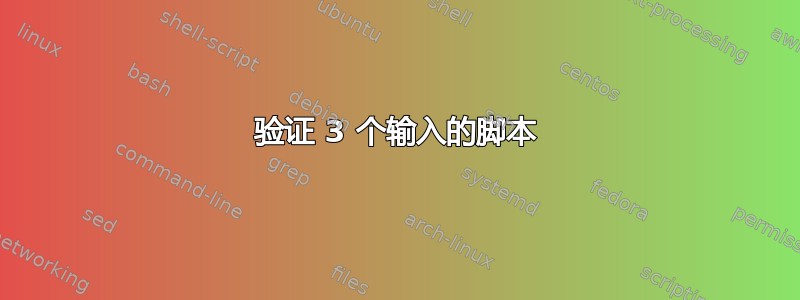
这就是我所拥有的。我正在尝试验证 3 个输入。第一个和第二个输入不会要求我输入正确的输入。怎么了?
#!/bin/bash
while :
do
echo "Please enter your tittle:"
read TITTLE
echo "Please enter your surname:"
read SURNAME
echo "Please enter your ID No."
read ID
if [ "$TITTLE" = "" ] || [ "${TITTLE//[!0-9]}" != "" ];
then
echo "Enter your valid tittle without special characters."
echo "Please try again."
exit 1
fi
if [ "$SURNAME" = "" ] || [ "${SURNAME//[!0-9]}" != "" ];
then
echo "Enter your valid surname without special characters."
echo "Please try again."
exit 1
fi
if [ "$ID" = "" ] || [ "${ID//[0-9]}" != "" ];
then
echo "Enter your valid ID No. without special characters."
echo "Please try again"
else
echo "Thank you" $TITTLE $SURNAME
break
fi
done
答案1
你的脚本退出一旦为标题或姓氏提供了无效输入,这将使循环变得无用。用于continue重新进行迭代。
但是,您不想仅仅因为用户输入了无效 ID 就强制用户再次输入其头衔和姓氏,因此您将需要三个输入循环而不是一个大循环;你从用户那里读到的每一件事都需要一个循环。
您的代码是不必要的重复,将其重写为三个循环会还进行不必要的重复。如果有单独的输入功能会更方便。
在下面的脚本中我已经做到了这一点。输入函数get_input采用“标签”(用户应输入内容的一些描述)和输入中每个字符必须匹配的模式。该get_input函数在标准输出上输出有效字符串,这就是我们在脚本主要部分的命令替换中调用它的原因。
我还将字符串验证移至其自己的函数中。这是为了使get_input函数更清晰,并将验证逻辑与输入逻辑分开。
验证使用的方法与您使用的方法相同,即从字符串中删除所有有效字符,然后测试是否还有剩余字符,在这种情况下,字符串将无法通过验证。
#!/bin/bash
# Succeeds if the first argument is non-empty and only
# consists of characters matching the pattern in the
# second argument.
is_valid () {
local string pattern
string=$1
pattern=$2
[ -n "$string" ] && [ -z "${string//$pattern}" ]
}
# Asks user for input until the given string is valid.
# The first argument is a text string describing what
# the user should enter, and the second argument is a
# pattern that all characters in the inputted data much
# match to be valid.
get_input () {
local label pattern
local string
label=$1
pattern=$2
while true; do
read -r -p "Please enter $label: " string
if is_valid "$string" "$pattern"; then
break
fi
# Complain on the standard error stream.
printf 'Invalid input, try again\n' >&2
done
printf '%s\n' "$string"
}
# Get data from user.
title=$( get_input 'your title' '[[:alpha:] ]' ) # title: only letters and spaces
surname=$( get_input 'your surname' '[[:alpha:] ]' ) # surname: same as title
id=$( get_input 'your ID no.' '[[:digit:]]' ) # ID: only digits
# Print what we got.
printf 'Title = "%s"\n' "$title"
printf 'Surname = "%s"\n' "$surname"
printf 'ID = "%s"\n' "$id"
如果还允许在标题或姓氏中使用点,请将模式从 更改[[:alpha:] ]为[[:alpha:]. ]。或者,您甚至可以减少限制,并允许使用[![:digit:]]任何非数字字符(包括标点符号等)。
要将输出保存在与运行脚本的用户同名的文件中,请重定向脚本本身的输出:
$ ./script.sh >"$USER.txt"
这将运行脚本并将输出重定向到名为 的文件$USER.txt,其中$USER是当前用户的用户名(此变量和$LOGNAME,通常已由 shell 和/或系统设置)。
您还可以在脚本本身中执行此操作,方法是将最后三行更改printf为
# Print what we got.
{
printf 'Title = "%s"\n' "$title"
printf 'Surname = "%s"\n' "$surname"
printf 'ID = "%s"\n' "$id"
} >"$USER.txt"
或者,如果您想在脚本中使用从用户读取的“姓氏”:
# Print what we got.
{
printf 'Title = "%s"\n' "$title"
printf 'Surname = "%s"\n' "$surname"
printf 'ID = "%s"\n' "$id"
} >"$surname.txt"
到还打印到终端,使用tee:
# Print what we got.
{
printf 'Title = "%s"\n' "$title"
printf 'Surname = "%s"\n' "$surname"
printf 'ID = "%s"\n' "$id"
} | tee "$surname.txt"
请注意,使用用户给出的输入可能允许脚本用户覆盖当前目录中的任意文件(假设权限允许这样做)。


